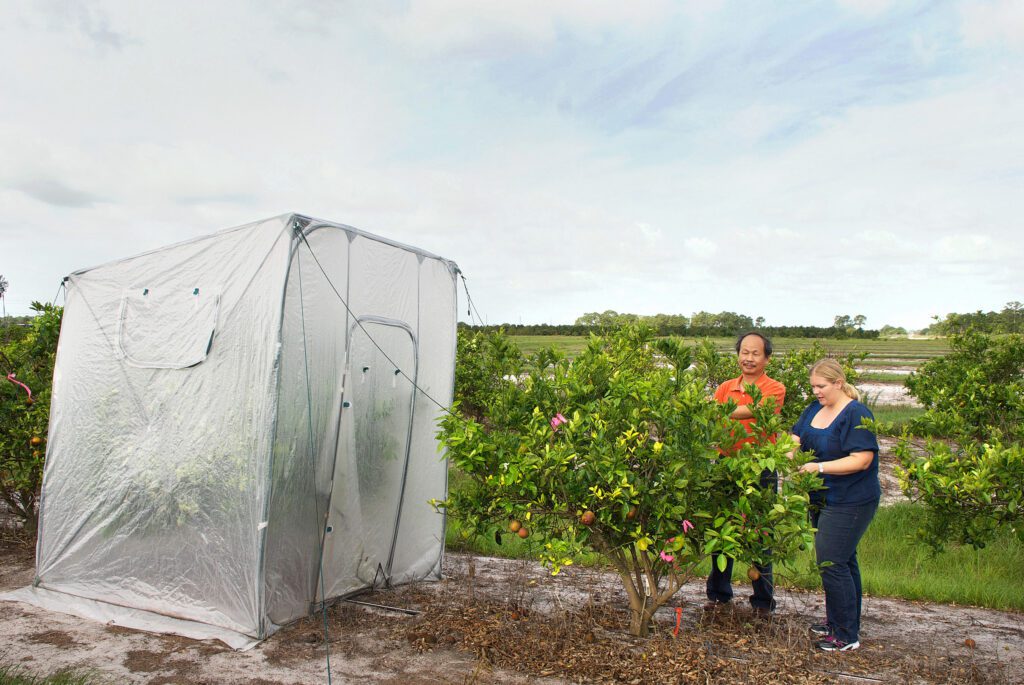Fight Against Greening Rages on with Continued Research
Citrus lobbyists had been searching for four years for a legislative vehicle to secure federal funding to fight the dreaded citrus greening disease, otherwise known as Huanglongbing or HLB. In the nation’s Farm Bill, otherwise known as the Agricultural Act of 2014, they found it.
The bill passed Congress, and was signed into law by President Barack Obama on February 7, with an approved $125 million— and the prospect of another $125 million— for research to defeat citrus greening. “It’s an unprecedent level,” asserts Janell Hendren, national affairs coordinator for Florida Farm Bureau Federation. “It’s a little later than we hoped, but better late than never.”
HLB has plagued the state’s citrus industry since it was found in southern Florida in 2005. The industry has mounted an intense campaign to defeat the dreaded disease, spending $70 million in grower-funded revenue in seven years. Yet the bacterial disease spread by the Asian psyllid still continues to attack the vascular system of citrus trees, misshaping fruit and potentially killing trees within two years. As a result, the industry with an annual economic impact of $9 billion in Florida— and the orange juice on our breakfast tables— are in serious danger.
The Farm Bill proved to be a good vehicle for the funding request because the archaic law, dating to 1938 and 1949, has been updated only with temporary provisions. It was a bipartisan, broadly supported piece of legislation.
Scientists have been making gains in the war on greening, but have yet to discover a solution or cure. Some efforts have focused on anti-microbials, heat treatment, more HLB-tolerant root stalks, and controlling or maiming the Asian psyllid.
U.S. Agriculture Secretary Tom Vilsack is expected to oversee the research initiative, in consultation with industry stakeholders from Florida, California, and Texas. A committee made up of nine representatives from those states will make funding decisions that must be approved by Vilsack.
Andrew Meadows, a spokesman for Florida Citrus Mutual, was expecting “a portion” to be awarded to the Citrus Research and Development Foundation, the Lake Alfred-based non-profit handling grower-supported research. “It’s been a long process of educating, communicating and lobbying,” Meadows says. The Lakeland-based Florida Citrus Mutual is the state’s largest grower organization.
“The Farm Bill apparently offers some opportunity for stakeholder participation in advising on the direction of the research,” says Dr. Harold Browning, CRDF’s chief operations officer. “It is not clear how ours or any other organization will play a role in decisions.”
If the funds supplement, rather than replace other funding sources, he would expect it to bring “additional scientific minds to this problem” and “accelerate progress.” “The ultimate solution to HLB will be implementation of a suite of new tools that will enable citrus growers to manage citrus in the presence of HLB,” he says. “That is how other established diseases are managed.”
Dr. Dean Gabriel, a professor of plant pathology at University of Florida in Gainesville, is one researcher who hopes to be included in future federal funding. Dr. Gabriel has discovered there is a latent virus inside the bacterium that has the potential to kill it. He is working to find a chemical means of triggering it.
“I think we’re getting close to triggering it with chemicals,” he says. “We have identified a part of it that is the trigger to make this suicide vest go off, if you will.” Dr. Gabriel is trying a find to find a chemical means of compromising the bacteria’s outer membrane. He also has studied the disease in Brazil, comparing it with the Florida bacteria.
He expects the earliest possible timeframe for a breakthrough would be three years, more likely it will be five years before current citrus greening research will result in practical gains. Ultimately, for scientists, what is important is “chronic funding,” he says. “It’s the sporadic stuff that will kill you.”
A couple of other changes in the Farm Bill are worthy of note for Central Florida agriculture, Hendren says. Those that use crop insurance will need to comply with conservation measures to receive federal crop insurance funding.
“If you want 50 percent of premiums paid, you’re going to have to take conservation measures,” she says. “You can still get crop insurance [without them]. You will just have to pay all the premiums yourself.”
“This was the best we could do,” explains Mike Stuart, co-chair of the Nationwide Specialty Crop Farm Bill Alliance, a coalition of 140 organizations, and FFVA president. “It wasn’t so much compromise. They said ‘thou shalt.’ We just didn’t think it was appropriate.” The impact of the change remains to be seen. “We’re going to learn quickly,” he adds.
Although agriculture funding took a 15 percent overall cut, specialty crop funding levels were maintained.

